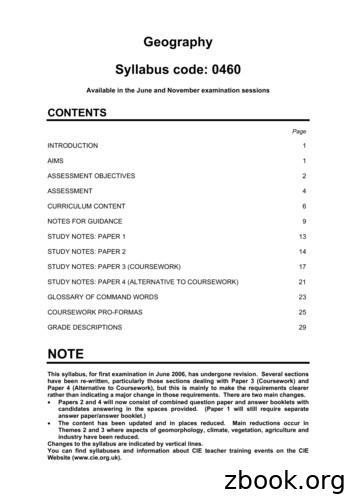IGCSE Geography 0460/21 Paper 2 Geographical Skills May .
Cambridge IGCSE * 8 2 2 2 8 5 1 9 3 4 *GEOGRAPHY0460/21May/June 2020Paper 2 Geographical Skills1 hour 30 minutesYou must answer on the question paper.You will need:Insert (enclosed)1:50 000 survey map (enclosed)CalculatorPlain paperProtractorRulerINSTRUCTIONS Answer all questions. Use a black or dark blue pen. You may use an HB pencil for any diagrams or graphs. Write your name, centre number and candidate number in the boxes at the top of the page. Write your answer to each question in the space provided. Do not use an erasable pen or correction fluid. Do not write on any bar codes. If additional space is needed, you should use the lined pages at the end of this booklet; the questionnumber or numbers must be clearly shown.INFORMATION The total mark for this paper is 60. The number of marks for each question or part question is shown in brackets [ ]. The insert contains additional resources referred to in the questions.This document has 20 pages. Blank pages are indicated.DC (PQ/CB) 180192/6 UCLES 2020[Turn over
21Study the map extract for Stoumont, Belgium. The scale is 1:50 000.(a) Fig. 1.1 shows some of the features around the main settlement at Stoumont. Study Fig. 1.1and the map extract, and answer the questions 8909900018602Fig. 1.1Using the map extract, identify the following features shown in Fig. 1.1:(i)feature A. [1](ii)the land use at B. [1](iii)the height above sea level of the contour at C. metres(iv)[1]feature D. [1](v)feature E. [1](vi)feature F. [1] UCLES 20200460/21/M/J/20
3(b) What is the six-figure grid reference of the junction at point G in Fig. 1.1?.[1](c) Fig. 1.2 is a cross section from point X to point Y in Fig. 1.1.N633 road4003003002002001001000metres abovesea levelmetres abovesea level4000Y020860X000880Fig. 1.2(i)The cross section shown in Fig. 1.2 is incomplete. Using information from the mapextract, draw a line on Fig. 1.2 to complete the cross section.[2](ii)In Fig. 1.2, use a labelled arrow to show the position of the L’Amblève river. UCLES 20200460/21/M/J/20[1][Turn over
4(d) Find the N645 road that runs from near the settlement of Chevron in the south west of themap extract to the bridge over the L’Amblève river.(i)What is the distance along the road from the south edge of the map to the bridge overthe L’Amblève river? Tick (3) one box below.Tick (3)3780 metres4780 metres5500 metres7780 metres[1](ii)What is the compass direction from the point where the road meets the south edge ofthe map to the bridge over the L’Amblève river?.(iii)[1]Measure the bearing from the point where the road meets the south edge of the map tothe bridge over the L’Amblève river. degrees(iv)[1]Describe the route of the N645 road. [3] UCLES 20200460/21/M/J/20
5(e) Fig. 1.3 shows an area in the north east of the map extract.0292030492919190908902038904Fig. 1.3Which three of the following statements describe the relief of the area shown in Fig. 1.3?Tick (3) only three boxes below.Tick (3)The highest point is over 550 m.It is an area of gentle slopes.It is lowest in the north.The lowest land is below 200 m.It is an area of deeply cut relief.There is a river flood plain.There is a plateau in the south.The slopes face north.There is a V-shaped valley.It is a mountainous area.[3](f)Look at the main settlement on the map extract at Stoumont. Give one reason for the growthof the settlement. [1][Total: 20] UCLES 20200460/21/M/J/20[Turn over
62Fig. 2.1 shows the estimated population growth of the continents between 1960 and 2100. Answerthe questions below using Fig. h AmericaNorth and 0802100Fig. 2.1(a) (i)What is the population of Africa expected to be in 2040?.(ii)[1]In which continent did the population grow the most between 1960 and 2000?.(iii)[1]In which continent is the population expected to grow the most between 2050 and 2100?.(iv)Estimate the world population in 2100. Circle one answer below.7 billion UCLES 2020[1]9 billion11 billion0460/21/M/J/2013 billion[1]
7(b) Table 2.1 gives information about the population in five countries.Table 2.1Growth rate(per thousand)(i)Birth rate(per thousand)Death rate(per thousand)7.3Net migration(per alculate the birth rate of India. per thousand(ii)[1]Which one of the five countries has the greatest change per thousand in its population?.(iii)[1]The population of Latvia is decreasing. Using Table 2.1 only, give two reasons why.1 .2 .[2][Total: 8] UCLES 20200460/21/M/J/20[Turn over
8BLANK PAGE UCLES 20200460/21/M/J/20
93Figs. 3.1, 3.2 and 3.3 (Insert) show three coastlines.(a) Identify each of the following landforms:(i)landform W in Fig. 3.1.(ii)landform X in Fig. 3.2.(iii)[1]landform Y in Fig. 3.2.(iv)[1][1]landform Z in Fig. 3.3.[1](b) Which one of the three photographs shows a coastline where deposition is the most importantprocess? Tick (3) one box below.Tick (3)Fig. 3.1Fig. 3.2Fig. 3.3[1](c) Explain how landform W, in Fig. 3.1, was formed. [3][Total: 8] UCLES 20200460/21/M/J/20[Turn over
104Fig. 4.1 shows the annual rainfall totals for ten years for a place with a hot desert climate and aplace with an equatorial climate.25002000annualrainfall(mm)1500Keyhot desertequatorial100050001 2 3 4 51 2 3number of yearsFig. 4.1(a) (i)What was the most frequent rainfall total for the place with a hot desert climate?.(ii)[1]What was the range of rainfall totals for the place with a hot desert climate?.(iii)What was the average annual rainfall for the place with a hot desert climate? Circle youranswer below.50 mm UCLES 2020[1]178 mm250 mm0460/21/M/J/20388 mm[1]
11(b) Using Fig. 4.1, compare the amount and variability of the annual rainfall for the place with ahot desert climate and the place with an equatorial climate.Amount of rainfall.Variability of rainfall.[2](c) Fig. 4.2 (Insert) shows a desert area where there has been recent rainfall. Explain how thevegetation shown in Fig. 4.2 has been affected by this rainfall. [3][Total: 8] UCLES 20200460/21/M/J/20[Turn over
125Table 5.1 shows energy consumption in the USA in 2007 and 2016.Table 5.1Source of energyPercentage of total energy g, electricity, transportCoalelectricity, manufacturingGeothermalheating, Natural gaselectricity, manufacturing23.329.2Oiltransport, manufacturing37.536.9Solarlight, heating, ricity0.52.4(a) Describe the changes in non-renewable energy consumption shown in Table 5.1. [3](b) Using evidence from Table 5.1, suggest why it is difficult to reduce consumption ofnon-renewable energy sources. [2] UCLES 20200460/21/M/J/20
13(c) Explain the importance of fuelwood to people in many countries. [3][Total: 8] UCLES 20200460/21/M/J/20[Turn over
146The United Nations Children’s Fund (UNICEF) is a United Nations programme which providesassistance to children and mothers in developing countries. Table 6.1 describes how UNICEFclassifies water supplies.Use information from Table 6.1 to answer the questions which follow.Table 6.1Type of water supplyDescriptionPercentageof the worldpopulationusing thistype of supplySafely managedDrinking water that is clean and from an improved watersource that is located in or near people’s homes71BasicDrinking water from an improved source, providedcollection time is not more than 30 minutes (includingqueuing)17LimitedDrinking water from an improved source for whichcollection time is more than 30 minutes (including queuing)4UnimprovedDrinking water from an unprotected well or spring6Surface waterDrinking water directly from a river, lake, stream or canal2Improved sources include: piped water, boreholes, protected wells, protected springs andpackaged or delivered water.(a) If the world population is 7 600 000 000, calculate how many people in the world drink surfacewater.[1](b) Suggest one type of graph which could be used to present the statistics in Table 6.1. UCLES 20200460/21/M/J/20[1]
15(c) Using evidence from Table 6.1 and your own knowledge, answer the questions below.(i)Explain the disadvantages of using unimproved and surface water supplies. [2](ii)Explain the disadvantages of using basic and limited water supplies. [2](iii)Suggest why it is difficult to provide the improved water sources shown in Table 6.1.
GEOGRAPHY 0460/21 Paper 2 Geographical Skills May/June 2020 1 hour 30 minutes You must answer on the question paper. You will need: Insert (enclosed) Plain paper 1:50 000 survey map (enclosed) Protractor Calculator Ruler INSTRUCTIONS Answer all questions. Use a black or dark blue pen. You may use an HB pencil for any diagrams or graphs.
IGCSE First Language English 12 IGCSE World Literature 13 IGCSE English as a Second Language 14 . IGCSE Business Studies 19 IGCSE Global Perspectives 21 IGCSE Geography 22 IGCSE History 23 IGCSE Sciences 24 IGCSE Cambridge Mathematics Extended & Core 26 . At BISP, Year 12 and 13 (Key Stage Five) students study the IB Diploma Programme (IBDP .
complete until we have received your payment. Please avoid paying on last day of normal stage . IGCSE CAMBRIDGE INTERNATIONAL EXAMINATIONS MAY/JUNE 2021 IGCSE FEES IN NAIRA . IGCSE GEOGRAPHY 0460 AY 57,255.00 88,529.00 133,730.00 IGCSE GEOGRAPHY 0460 BY 58,142.00 89,416.00 134,617.00 IGCSE GEOG
IGCSE ARABIC for Native Arabic Speakers - Edexcel 11 GCSE ART & DESIGN - Edexcel 13 IGCSE BUSINESS STUDIES - Cambridge 15 IGCSE ECONOMICS - Cambridge 17 IGCSE COMPUTER SCIENCE - Cambridge 19 GCSE DRAMA - Edexcel 20 IGCSE ENGLISH LANGUAGE - Cambridge 22 IGCSE ENGLISH LITERATURE - Edexcel 22 IGCSE GEOGRAPHY - Edexcel 25
GEOGRAPHY 0460 IGCSE (2006) 1 INTRODUCTION International General Certificate of Secondary Education (IGCSE) syllabuses are designed as two-year courses for examination at age 16-plus. This syllabus is available for examination in both the June and November sessions. All IGCSE syllabu
Cambridge IGCSE Geography 0460 3 How to use this guide The guide describes what you need to know about your Cambridge IGCSE Geography examination. It will help you to plan your revision programme and will explain what we are looking for. Not all the information will be relevant to you. You
Upcoming Cambridge IGCSE training in Rome 05-06 April 2017 Introductory Cambridge IGCSE English as a Second Language (0510) Introductory Cambridge IGCSE International Mathematics (0607) Introductory Cambridge IGCSE Art and Design (0400) Extension Cambridge IGCSE Geography (0460) 07-08 April 2017
Revision Checklist for IGCSE Geography 0460 A Guide for Students . This Paper will be in a booklet with spaces to write your answers. IGCSE Geography 0460 Revision Checklist . . and decision making Being able to make judgements based on information and recognise possible
AutoCAD education, and apply them right away to your fi rst real drawing. Let us take a look at the Layers Properties Manager. This is AutoCAD’s Layers dialog box, where everything important related to layers happens. Open a new fi le and, if you decide to use toolbars, also bring up the Layer toolbar. We take a closer look at that toolbar in Section 3.3 , but for now you need only the .























